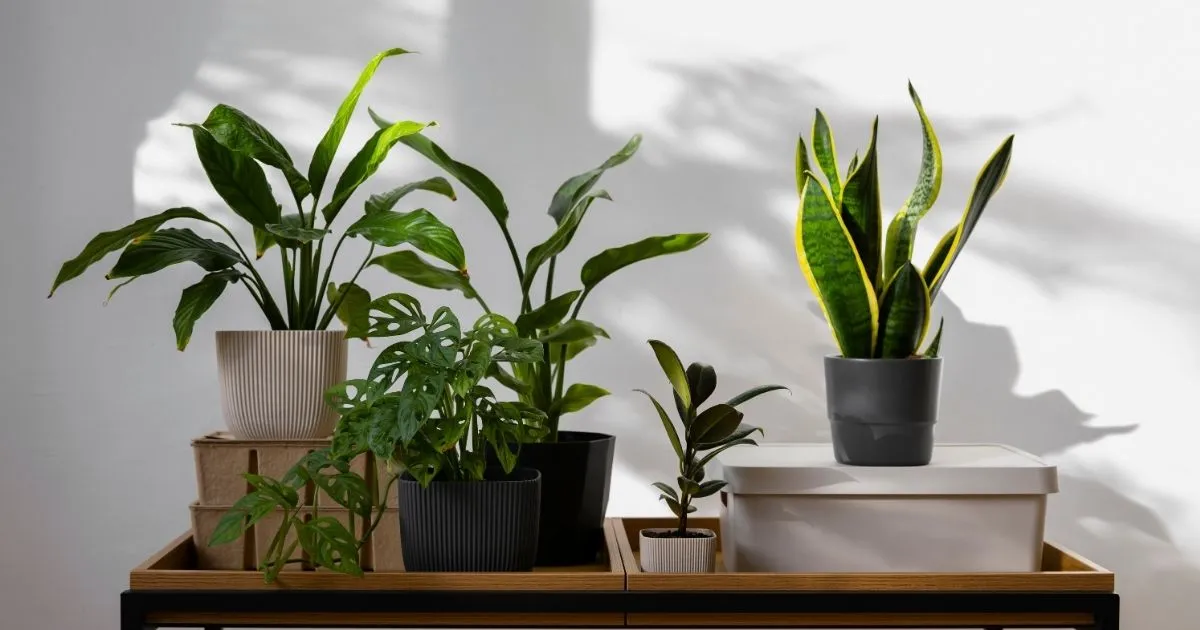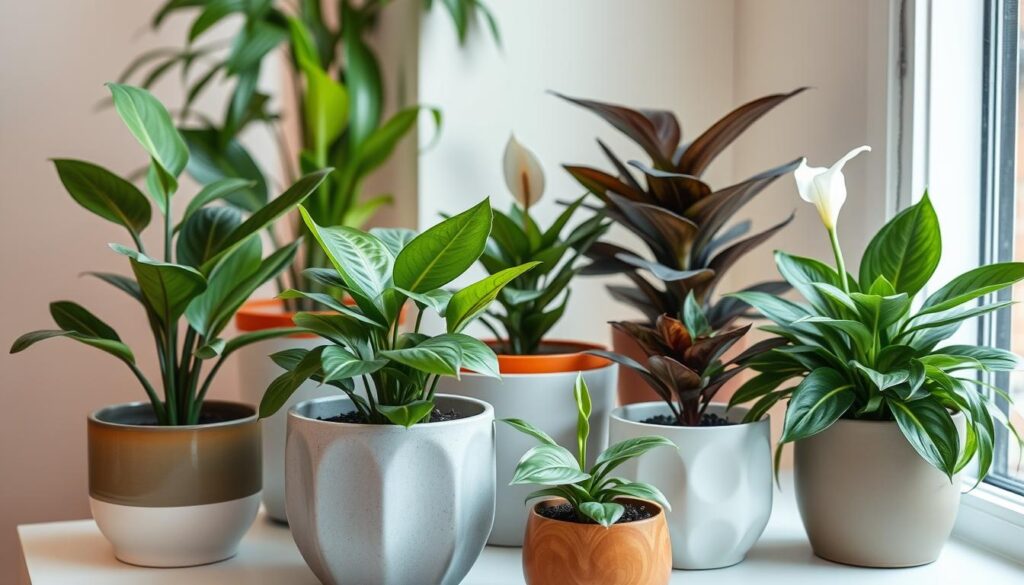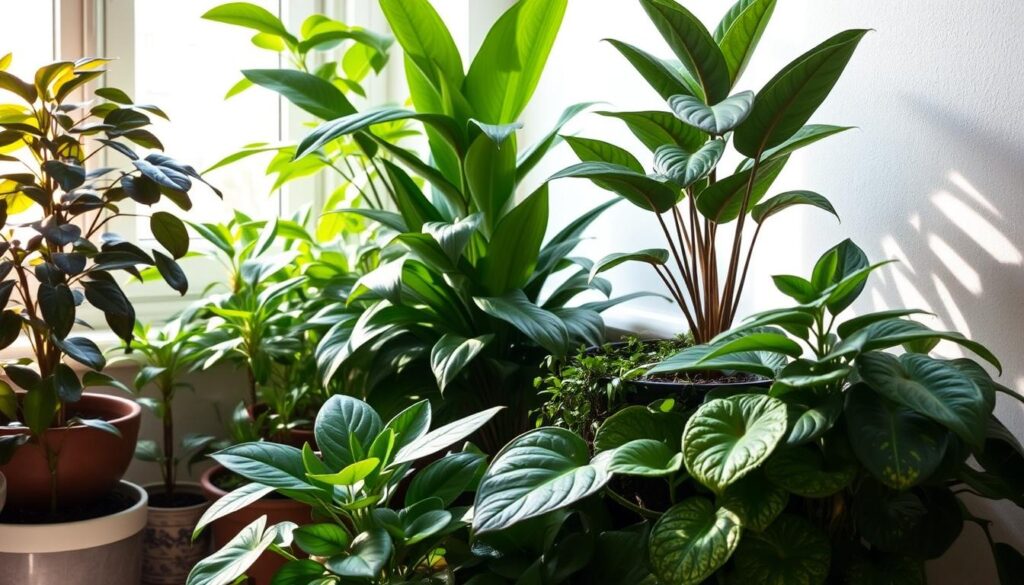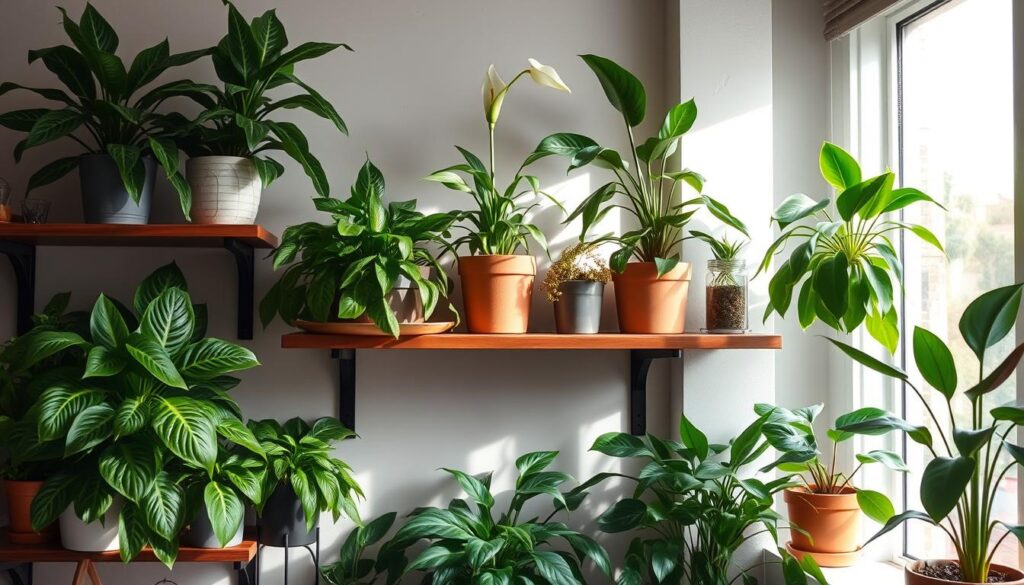Blog
Best Easy Care Indoor Plants for Your Home

Bringing the outdoors inside is more appealing than ever. With the rise of low-maintenance houseplants, it’s easy to add nature to your home. This guide will show you the best easy-care indoor plants for your home.
Houseplants make a room look better and offer many benefits. They purify the air and improve your well-being. In this article, we’ll look at many low-maintenance indoor plants. They’re great for busy people and those new to plants. Get ready to find your next favorite green companion and make your home a peaceful oasis.

Table of Contents
Why Indoor Plants Are Essential for Modern Living
In today’s fast-paced world, air-purifying plants in our homes are key. They make our spaces look better and offer many health benefits and psychological effects. These benefits help us feel better overall.
Health Benefits of Indoor Plants
Air-purifying plants help clean our indoor air. They remove harmful pollutants like VOCs, making it safer to breathe. They also help lower stress, blood pressure, and boost focus and productivity.
Psychological Effects of Living with Plants
Indoor plants do more than just clean the air. They positively affect our minds. The idea of biophilic design shows our natural connection to nature. Being around plants makes us calmer, more focused, and happier.
Adding air-purifying plants to our homes is more than just a style choice. It’s a way to improve our health and happiness. By bringing nature indoors, we create spaces that are not only beautiful but also good for our well-being.
“Surrounding ourselves with nature, even in small ways, can have a significant impact on our overall health and happiness.”
Understanding Light Requirements for Indoor Plants
Choosing the right indoor plants is key for their health. The amount of natural light in your home matters a lot. Knowing the light needs of plants helps create a lush indoor garden.
There are three main light levels for indoor plants:
- Low light: These plants do well in dim spots, like corners. Examples include snake plants, ZZ plants, and pothos.
- Bright indirect light: Plants that love bright, indirect light do great near windows but not in direct sun. Philodendrons, Chinese evergreens, and peace lilies fit this category.
- Direct sunlight: Some plants, like succulents and citrus trees, need direct sun. Place them in the sunniest spots.
To give your plants the best light, think about your room’s layout and window placement. South-facing windows get the most sun. East- and west-facing windows offer bright, indirect light. North-facing windows are best for low light plants.
| Light Condition | Recommended Plants |
|---|---|
| Low Light | Snake Plant, ZZ Plant, Pothos |
| Bright Indirect Light | Philodendron, Chinese Evergreen, Peace Lily |
| Direct Sunlight | Succulents, Citrus Trees |
Knowing what light plants need helps you create a beautiful indoor garden. It not only makes your home look better but also improves your mood and health.
Easy Care Indoor Plants for Beginners
Starting with indoor plants can seem scary if you’re new. But, there are many easy plants that are hardy and don’t need much care. These plants are great for beginners.
Snake Plant (Sansevieria)
The snake plant, also called the mother-in-law’s tongue, is a great choice for beginners. It has striking leaves and can grow well in different light. These plants can survive without water for a long time, perfect for busy people.
ZZ Plant (Zamioculcas zamiifolia)
The ZZ plant is also popular for beginners. It has thick leaves and can handle many light conditions. Plus, it can go without water for a while, making it easy to care for.
Pothos (Epipremnum aureum)
Pothos is a classic choice for indoor gardening. It has long vines and can grow in various light. It’s also good at cleaning the air, making it a great choice for homes or offices.
Adding these easy plants to your home can bring many benefits without the stress. They’re perfect for both new and experienced plant lovers, adding life and energy to your space.
Best Low-Light Plants for Dark Corners
Bringing nature indoors is easy, even in dark spots. Find the shade-tolerant plants that love low light. They’re great for indoor plants for offices or any dark corner.
The ZZ plant (Zamioculcas zamiifolia) is a top pick. It handles a range of light, from bright to dark. Its shiny leaves and strong stems mean it’s easy to care for.
The Chinese Evergreen (Aglaonema) is another strong choice. It brightens dark spots with its colorful leaves. Just remember to keep the soil moist but not too wet.
The Cast Iron Plant (Aspidistra elatior) adds elegance. It’s very hardy and does well in low light. Its big leaves make any space look better, perfect for indoor plants for offices.
“The key to success with low-light plants is understanding their specific needs and providing the right environment.”
Choosing the right low light houseplants brings nature to dark spots. With a bit of care, these plants will thrive. They’ll add color and clean the air for you.

Drought-Tolerant Indoor Plants That Thrive on Neglect
If you’re always busy or travel a lot, keeping a lush indoor garden can be tough. But, there are many drought-resistant houseplants that need little care. These plants are great for anyone who wants greenery without the constant watering.
Chinese Evergreen (Aglaonema)
The Chinese Evergreen is tough and can grow well in many conditions. It does well in low light and doesn’t need much water. Its colorful leaves and air-purifying abilities make it a standout low-maintenance plant.
Cast Iron Plant (Aspidistra elatior)
The Cast Iron Plant is named for its toughness. It can handle neglect and low light. It only needs water now and then, making it perfect for those who forget to water their plants.
| Plant | Light Requirements | Watering Needs |
|---|---|---|
| Chinese Evergreen (Aglaonema) | Partial to full shade | Allow soil to dry out between waterings |
| Cast Iron Plant (Aspidistra elatior) | Partial to full shade | Water sparingly, every 2-3 weeks |
These drought-tolerant indoor plants are ideal for anyone who forgets to care for their plants or travels a lot. They can thrive with little attention, allowing you to enjoy greenery without the constant upkeep.
Air-Purifying Indoor Plants for Better Air Quality
Breathing clean air is key to our health, but we often spend time indoors. Luckily, NASA clean air study-backed, oxygen-producing plants can act as natural air filters.
NASA found houseplants that remove toxins like benzene and formaldehyde from the air. These air-purifying indoor plants bring nature indoors. They help us breathe better and live healthier.
Top Air-Purifying Plants for Your Home
- Peace Lily (Spathiphyllum): Known for removing benzene and formaldehyde from the air.
- English Ivy (Hedera helix): Effective in removing formaldehyde and other toxins.
- Dracaena: Thrives in different lights and filters out airborne toxins.
- Philodendron: Grows fast and removes harmful substances like xylene and toluene.
- Snake Plant (Sansevieria): Releases oxygen at night and removes benzene, formaldehyde, and xylene.
By placing these oxygen-producing plants around your home, you can make it healthier. Enjoy cleaner, fresher air.

“Incorporating air-purifying plants into your home is a simple and effective way to improve indoor air quality and create a healthier living space.”
Pet-Friendly Indoor Plants for Safe Homes
Creating a lush, green home is important, but it must be safe for pets. Some indoor plants can harm cats, dogs, and other pets. Luckily, there are many beautiful, safe plants for homes with pets.
Boston Fern
The Boston fern adds a lush touch to any room and is safe for pets. It’s non-toxic to cats and dogs, making it perfect for homes with pets. Boston ferns need bright, indirect light and regular watering to stay green.
Spider Plant
The spider plant is known for its long, ribbon-like leaves. It’s a safe choice for cat-safe houseplants and non-toxic to dogs. It can handle different light and soil conditions, making it great for new plant owners with pets. Plus, it produces offsets for easy sharing.
Parlor Palm
The parlor palm brings tropical elegance to any room and is safe for pets. It prefers indirect sunlight and is non-toxic to cats and dogs. Keep the soil moist to keep its green fronds looking vibrant.
Choosing these non-toxic plants helps create a safe, beautiful home for pets. With some research and careful picking, you can enjoy indoor plants without risking your pets’ health.
Essential Care Tips for Healthy Indoor Plants
To keep indoor plants healthy, you need a good watering schedule, smart fertilizing, and a solid plant care routine. These tips will help your plants stay green and make your home feel welcoming.
Watering Techniques
Watering right is key for your plants. Don’t overwater, which can cause root rot, or underwater, which makes them wilt. Create a watering plan that fits each plant’s needs. Consider the plant type, pot size, and where it lives.
Fertilizing for Optimal Growth
Fertilizing regularly is vital for your plants to grow well and look great. Use a balanced, water-soluble fertilizer and follow the directions, usually every few weeks when they’re growing. Change the schedule as needed based on your plants’ growth.
Establishing a Sustainable Care Routine
Having a detailed plant care routine is crucial for your plants’ health. This includes pruning, repotting, and cleaning leaves. Set a regular time for these tasks. Remember, each plant has its own needs.
“The key to keeping your indoor plants healthy is to be attentive to their needs and establish a consistent care routine.”
By sticking to these watering, fertilizing, and plant care routine tips, your indoor plants will flourish. They’ll make your home a lively, natural space.
Common Indoor Plant Problems and Solutions
We all love our indoor plants, but they can face unexpected challenges. Pests and fungal diseases can harm our green friends. But don’t worry! With the right knowledge, you can solve these problems and keep your plants happy.
Pest Management
Dealing with plant pests can be frustrating. These pests include spider mites and aphids. To fight them, check your plants often for signs of pests. If you find any, use a gentle insecticide or introduce natural predators like ladybugs.
Disease Prevention
Indoor plants can also get fungal diseases. Root rot and powdery mildew can harm them. To prevent this, make sure your plants get the right water, sunlight, and air. Use fungicides if needed and remove sick leaves to stop the disease from spreading.
Troubleshooting Growth Issues
Yellow leaves or stunted growth can worry you. These problems might come from not enough nutrients or stress. Check your plants and adjust their care as needed. With some effort, you can fix these issues and help your plants grow well.
By tackling plant pests, fungal diseases, and growth issues, you can keep your indoor garden healthy. With patience and the right care, your plants will add beauty and life to your home.
Decorating Your Home with Indoor Plants
Adding indoor plants to your home can make any space better. It brings a natural, lush feel that improves your living area. You can use plants in many ways, from placing them strategically to creating eye-catching displays. This opens up endless possibilities for plant styling.
Living walls are a great idea. They involve hanging plants vertically to make a beautiful, green centerpiece. This not only looks great but also cleans the air and boosts your health. Mix different plants, like vines, small leaves, and colorful flowers, for a lively display.
Or, group plants of different sizes, textures, and colors to make a beautiful scene. Use unique containers, like old jars or hanging baskets, to add character to your plants. By carefully arranging your plants, you can turn any room into a peaceful, nature-filled space that shows off your style.
FAQ
What are the benefits of incorporating indoor plants into my home?
Indoor plants can make your home better in many ways. They help clean the air by removing harmful toxins. They also reduce stress and make you feel better mentally. Plus, they make your home look nicer.
How do I choose the right indoor plants for my home based on lighting conditions?
Think about how much light your home gets. Choose plants that match your light levels. For dark spots, pick plants like ZZ plants and snake plants. For brighter areas, go for pothos and philodendrons.
What are some easy-care indoor plants that are suitable for beginners?
Great plants for beginners include snake plants, ZZ plants, and pothos. These plants are easy to care for. They can handle a little neglect.
How do I keep my indoor plants healthy and thriving?
To keep your plants healthy, water them regularly. Make sure they get the right amount of light. Use a balanced fertilizer to feed them.
Check for pests or diseases often. Take steps to prevent problems and keep your plants growing well.
Are there any indoor plants that are safe for households with pets?
Yes, there are safe plants for homes with pets. Boston ferns, spider plants, and parlor palms are good choices. They are non-toxic and safe for cats and dogs.
How can I incorporate indoor plants into my home decor?
Try different ways to display your plants. Use various containers and creative displays. Hang plants or create terrarium gardens. Even living walls can add a natural touch to your home.
Read more Grow Your Hoya Carnosa
One thought on “Best Easy Care Indoor Plants for Your Home”
Comments are closed.